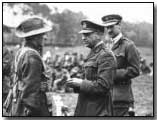Battles - The Battle of Le Hamel, 1918
 The Battle of Le Hamel, a successful engagement launched
by the Allies on 4 July 1918, was of itself a small action, but was a
necessary precursor to further advances by
Sir
Henry Rawlinson's Fourth Army on the Western Front.
The Battle of Le Hamel, a successful engagement launched
by the Allies on 4 July 1918, was of itself a small action, but was a
necessary precursor to further advances by
Sir
Henry Rawlinson's Fourth Army on the Western Front.
It was the latest in a series of local actions conducted by the Allies to end in success, and came at a time when the offensive morale of the German army was starting to fall; at the same time the Germans were falling prey to the worldwide influenza pandemic, with severe results in the confined trench environment.
The attack was intended to straighten the salient opposite Rawlinson's British Fourth Army east of Amiens (occupied by Georg von der Marwitz's Second Army) by capturing Le Hamel and its flanking woods. This would remove the danger that subsequent large-scale artillery operations conducted by Rawlinson would suffer exposure to German flanking fire.
The operation was overseen by new Australian commander John Monash and executed by his 4th Division. In planning the action Monash - an advocate of so-called 'peaceful penetration' - made effective use of both massed machine guns and heavy tanks (some 60 of the latter) while ensuring absolute secrecy in planning. He also eschewed the usual tactic of preliminary bombardment, which invariably served only to warn the enemy that an attack was imminent.
The operation was not however exclusively an Australian affair; four U.S. companies, currently training with the Australians, were also drafted in.
When launched on 4th July 1918 with a co-ordinated barrage of tanks, artillery and warplanes, the Australians and Americans found the lines opposite to be only lightly defended, and the attack caught the Germans entirely by surprise.
Both Le Hamel and its woods were easily taken by the Australians and Americans in just 93 minutes, and the German line effectively straightened, the salient removed.
Casualties among the Allies were at the cost of approximately 1,000 men. In turn the Allies captured some 1,500 German prisoners.
A 'flying pig' was a mortar bomb.
- Did you know?
